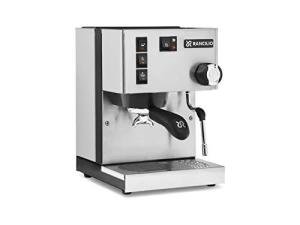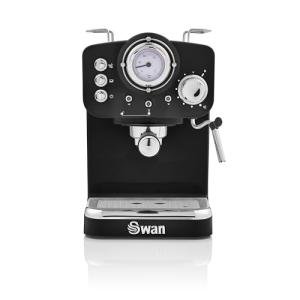If you love rich, bold coffee, an espresso machine is a must-have in your kitchen. These machines whip up delicious shots of espresso in no time, bringing that café experience right to your home. Whether you’re a newbie or a seasoned barista, you’ll find plenty of options that fit your style and budget.
Espresso Coffee Machines
Brew barista-quality espresso at home with our top-rated espresso coffee machines
Product List




Espresso coffee machines have become an essential appliance in many households, bringing the café experience right into the comfort of one's home. From sleek, compact models to professional-grade machines, the options can seem overwhelming. This guide explores the various types of espresso machines, features to consider, maintenance tips, and frequently asked questions to help prospective buyers make informed decisions.
Understanding Espresso Machines
Espresso machines work by forcing hot water through finely-ground coffee at high pressure, resulting in a concentrated beverage known as espresso. This rich coffee serves as the base for numerous coffee drinks, including lattes, cappuccinos, and Americanos.
Types of Espresso Machines
Choosing the right type of espresso machine is crucial for creating the perfect cup of espresso. The following table summarizes the primary types and their characteristics.
| Type | Description | Pros | Cons |
|---|---|---|---|
| Manual | Users control every aspect of brewing; typically lever-operated. | Complete control, great for enthusiasts. | Steep learning curve, requires practice. |
| Semi-Automatic | Uses an electric pump but allows users to control extraction time. | Balance of control and convenience. | Still requires skill to achieve consistency. |
| Automatic | Automatically controls water flow; easier to use than semi-automatic. | Consistent results, less skill required. | Limited control over brewing process. |
| Superautomatic | Machines that grind, tamp, brew, and self-clean with minimal user input. | Convenience and speed, ideal for busy users. | Less customization, can be expensive. |
| Capsule/Espresso Pods | Uses pre-packaged capsules or pods for brewing. | Quick and easy, minimal cleanup. | Higher cost per serving, limited flavor options. |
What to Look for in an Espresso Machine
When considering an espresso machine, buyers should evaluate several important features:
-
Size and Design
- Consider the space available in your kitchen. Some machines are compact, while others may require more room.
-
Brew Quality
- Look for machines that maintain stable temperature and pressure for the best extraction.
-
Steam Wand
- If you enjoy frothy milk beverages, a quality steam wand is essential for creating microfoam.
-
Ease of Cleaning
- Machines that are easier to clean often encourage regular use. Look for removable parts and self-cleaning features.
-
Durability and Material
- Stainless steel machines are generally more durable than plastic ones.
-
Price
- Set a budget, keeping in mind that a higher price is often associated with better performance and durability.
Popular Brands of Espresso Machines
The market offers a variety of brands, each with unique offerings. The following table charts some of the most popular espresso machine brands along with their features.
| Brand | Notable Models | Key Features |
|---|---|---|
| Breville | BES870XL, BES920XL | Dual boiler system, user-friendly controls |
| De'Longhi | EC155, La Specialista | Compact size, excellent steam wands |
| Gaggia | Classic Pro, Anima | Great for beginners, solid build quality |
| Rancilio | Silvia | Commercial-grade features for home use |
| Nespresso | VertuoPlus, Essenza Mini | Convenient pod system, consistent quality |
Maintaining Your Espresso Machine
Regular maintenance is vital to ensure the longevity of an espresso machine. Here are some essential maintenance tips:
-
Cleaning
- Clean the portafilter, basket, and steam wand after each use.
-
Descaling
- Descale the machine regularly to prevent mineral buildup. The frequency depends on water hardness.
-
Replacing Parts
- Monitor and replace worn parts, such as gaskets and filters, to maintain machine performance.
-
Regular Calibration
- Professional machines need periodic calibration to ensure consistency in pressure and temperature.
Frequently Asked Questions (FAQ)
1. How much should I expect to spend on an espresso machine?
Prices can range from around £100 for basic models to over £2,000 for professional machines. A good mid-range machine often costs between £500 to £1,500.
2. Can I make cappuccinos and lattes with an espresso machine?
Yes, espresso machines typically come with steam wands for frothing milk, enabling you to prepare a wide range of coffee drinks.
3. What is the difference between espresso and regular coffee?
Espresso has a higher concentration of coffee solids and flavors due to the brewing method, which uses pressure. Regular coffee is usually made using a drip or pour-over method.
4. Do I need to buy a grinder separately?
While some machines come with built-in grinders, many enthusiasts prefer to invest in a separate burr grinder for better control over grind size and consistency.
5. How often should I descale my espresso machine?
This depends on your water hardness but generally, descaling is recommended every 1 to 3 months.
Choosing the right espresso machine is crucial for coffee enthusiasts who want to create café-style drinks at home. With various types, features, and brands to consider, it's important to evaluate personal needs and preferences. A well-maintained espresso machine will provide years of delicious espresso and specialty coffee, making it a worthwhile investment for any coffee lover. Happy brewing!